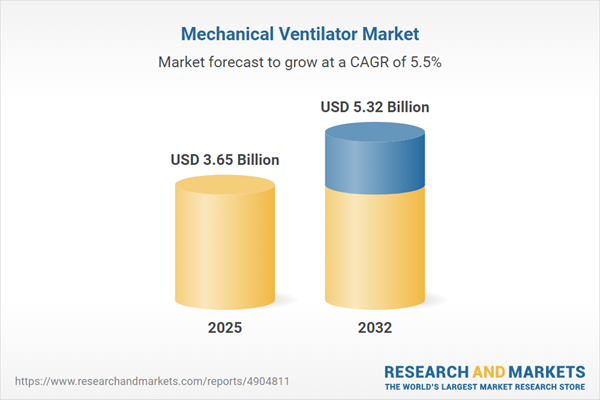Speak directly to the analyst to clarify any post sales queries you may have.
The mechanical ventilator market is experiencing substantial evolution, driven by increasing global respiratory health challenges and rapid advances in healthcare technology. Senior decision-makers will benefit from intelligence that enables swift adaptation to market shifts while ensuring optimal patient outcomes and operational efficiency.
Market Snapshot: Growth Trajectory for Mechanical Ventilators
The global mechanical ventilator market grew from USD 3.46 billion in 2024 to USD 3.65 billion in 2025. Continuing at a CAGR of 5.52%, it is projected to reach USD 5.32 billion by 2032. This expansion reflects increasing demand due to a rise in chronic respiratory diseases, critical care advancements, and continual innovation across care settings. Strategic responses to changing healthcare systems, pandemic preparedness, and regulatory policies are reshaping this industry landscape.
Scope & Segmentation of the Mechanical Ventilator Market
This report offers deep segmentation analysis to equip leaders with actionable insights:
- Product Types: Invasive ventilators; Non-invasive ventilators including bilevel positive airway pressure, continuous positive airway pressure, negative pressure, and positive pressure ventilators
- Modes of Ventilation: Negative pressure and positive pressure ventilation options
- Mobility: Portable ventilators for home and point-of-care; Stationary units for hospitals and larger clinical settings
- Patient Categories: Adult, geriatric, and pediatric ventilator models designed for age- and condition-specific needs
- Applications: Emergency and resuscitation, neurological support, post-surgical management, and chronic disease management
- End-use Environments: Hospitals and clinics, home care, ambulatory surgical centers, emergency and transport centers
- Geographical Coverage: Americas (including United States, Canada, Mexico, Brazil, Argentina, Chile, Colombia, Peru), EMEA (covering United Kingdom, Germany, France, Russia, Italy, Spain, Switzerland, Netherlands, Sweden, Poland, United Arab Emirates, Saudi Arabia, Qatar, Turkey, Israel, South Africa, Nigeria, Egypt, Kenya), and Asia-Pacific (including China, India, Japan, Australia, South Korea, Indonesia, Thailand, Malaysia, Singapore, Taiwan)
- Key Market Players: Phillips Respironics, Dräger, GE Healthcare, Medtronic, Hamilton Medical, ResMed, Nihon Kohden Corporation, and other global and regional manufacturers
Key Takeaways for Strategic Decision-Makers
- Mechanical ventilators increasingly combine advanced monitoring, adaptive ventilation algorithms, and intuitive interfaces, facilitating precision-driven respiratory support in both acute and chronic care environments.
- Pandemic-readiness has accelerated adoption of modular technology and remote monitoring, allowing providers and manufacturers to respond swiftly to fluctuating care demands and supply chain challenges.
- Regulatory developments now prioritize rapid device approval and patient safety, especially as AI-driven algorithms and cloud connectivity expand device capabilities and data integration across healthcare ecosystems.
- Segmented product offerings for adult, pediatric, and geriatric populations support tailored therapy while strengthening after-sales service strategies and optimizing investment allocation.
- Collaborative ventures, licensing, and cross-industry alliances among established brands and agile newcomers enhance innovation speed and broaden global distribution networks.
- Growth is underpinned by both legacy investments in healthcare infrastructure and new government incentives supporting local manufacturing and technology transfer across emerging markets.
Tariff Impact: Navigating US Policy Shifts
Revised United States tariffs in 2025 have impacted manufacturer cost structures by elevating duties on components like compressors, control modules, and sensors. Strategies such as nearshoring, supplier diversification, and implementation of lean manufacturing are being employed to mitigate margin pressures. The result is greater operational resilience and cost management, supporting competitiveness despite logistical and regulatory fluctuations for ventilator suppliers and service providers.
Methodology & Data Sources
This report utilizes a mixed-methods approach. Primary research includes interviews with intensive care specialists, procurement managers, and OEM executives, ensuring high relevance and insight accuracy. Secondary sources comprise peer-reviewed journals, patent filings, regulatory data, and financial disclosures. Quantitative models provide financial and pricing analysis, while thematic coding captures evolving trends in product innovation and adoption strategies.
Why This Report Matters for Industry Leaders
- Enables accurate benchmarking of emerging technologies, market structure, competitive moves, and end-user demands critical for next-phase investment planning and resource optimization.
- Supports informed risk management through robust analysis of regulatory and tariff impacts, helping strengthen supply chain resilience and strategic agility for senior stakeholders.
- Guides manufacturers toward portfolio alignment with new healthcare delivery models, improving customer engagement and adaptation to region-specific clinical requirements.
Conclusion
The mechanical ventilator market is transitioning rapidly as technology, regulation, and clinical priorities evolve. Decision-makers equipped with the latest segmented intelligence and strategic recommendations will be best positioned to drive operational excellence and market leadership.
Additional Product Information:
- Purchase of this report includes 1 year online access with quarterly updates.
- This report can be updated on request. Please contact our Customer Experience team using the Ask a Question widget on our website.
Table of Contents
3. Executive Summary
4. Market Overview
7. Cumulative Impact of Artificial Intelligence 2025
Companies Mentioned
The companies profiled in this Mechanical Ventilator market report include:- Aeonmed Co., Ltd.
- Air Liquide Medical Systems S.A.
- Allied Medical, LLC
- Avasarala Technologies Limited
- Bio-Med Devices, Inc.
- Bunnell Incorporated
- Drägerwerk AG & Co. KGaA
- Fisher & Paykel Healthcare Corporation Limited
- GE HealthCare Technologies Inc.
- Getinge AB
- Hamilton Medical AG
- Heyer Medical AG
- Koninklijke Philips N.V.
- Magnamed Tecnologia Médica S/A
- Medtronic plc
- Mindray Medical India Pvt. Ltd.
- Nihon Kohden Corporation
- ResMed Inc.
- Schiller AG
- Siare Engineering International Group S.r.l.
- Smiths Group plc
- ZOLL Medical Corporation
Table Information
| Report Attribute | Details |
|---|---|
| No. of Pages | 197 |
| Published | November 2025 |
| Forecast Period | 2025 - 2032 |
| Estimated Market Value ( USD | $ 3.65 Billion |
| Forecasted Market Value ( USD | $ 5.32 Billion |
| Compound Annual Growth Rate | 5.5% |
| Regions Covered | Global |
| No. of Companies Mentioned | 23 |









